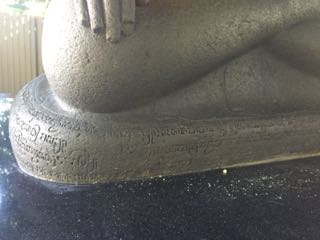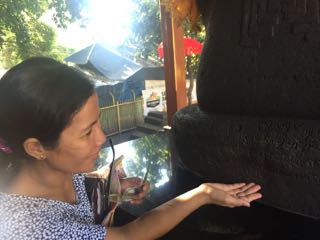Wurare Inscription of Joko Ḍolog (1289 CE)

The Wurare inscription, is a Sanskrit inscription found on the base of the statue of Joko Ḍolog (literally, ‘plump lad’), now placed in a park in the city center of Surabaya. The statue was originally found in the village of Lĕmah Tulis near the town of Trowulan, which was believed to the site of the buried capital of the Majapahit Empire (1293-1527), and was moved to its present site during the Dutch Period in 1817. The inscription itself is dated to 1289 CE, and it informs us of a Buddhist sage Bharaḍa who drew the boundary between the kingdoms of Jaṅgala and Pañjalu to avoid a feud during King Airlaṅga’s reign in 1052 CE. While locals refer to the statue as the Akṣobhya Buddha, scholars have speculated its true identity, which was for a long time thought to be King Kṛtanāgara (r. 1254-1292), the last and most important ruler of the Siṅhasari kingdom of Java. According to Gompert et al’s latest study, the statue should be none other than the Buddhist sage Bharaḍa himself as the famous Dutch archaeologist Herni Maclaine Pont first suggested in 1926/1930. According to Pont’s excavation report of this site where the statue was first found, there was a burnt wooden structure which suggests an enclosed pavilion with a religious function, together with cremation urns of bone remains of children. Piecing all the evidences together, it has been suggested that the site must have been associated with the 11th century Buddhist sage Bharaḍa’s hermitage, around which cremated remains were buried. Following the suggestion of Gompert et al 2012, the name of the place should be Awurare (with the ‘a’ elided due to sandhi following a vowel in verse 13), meaning “bones of children” (awu-rare) in old Javanese.
The Sanskrit inscription consists of 19 verses. I have restored the text to standard Sanskrit orthography with emendations made in earlier editions by Kern, Poerbatjaraka and Gompert et al.
ādau namāmi sarvajñaṃ jñānakāyan tathāgataṃ /
sarvaskandhātiguhyasthaṃ sadasatpakṣavarjitam //l//
anw atas sarvasiddhiṃ vā vande ‘haṃ gauravāt sadā
śākakālam idaṃ vakṣye rajakīrtiprakāśanam //2//
yo purā paṇḍitaś śresṭḥa āryo bharāḍ abhijñātaḥ /
jñānasiddhiṃ samāgamyā ‘bhijñālābho munīśvaraḥ //3//
mahāyogīśwaro dhīraḥ sattveṣu karuṇātmakaḥ /
siddhācāryo mahāvīro rāgādikleśavarjitaḥ //4//
ratnākarapraṃāṇān tu dvaidhīkṛtya yavāvanīṃ /
kṣitibhedanaṃ sāmarthya kumbhavajrodakena vai //5//
parasparavirodhena nṛpayor yuddhakāṅkṣinoḥ /
estasmāj jaṅgalety eṣā paṃjaluviṣayā smṛtā //6//
kin tu yasmāt rarakṣemāṃ jayaśrīviṣṇuvarddhanaḥ /
śrījayavarddhanībhāryo jagannāthottamaprabhuḥ //7//
ājanmapariśuddhāṅgaḥ kṛpāluḥ dharmatatparaḥ /
pārthivānandanaṃ kṛtvā śuddhakīrtiparākramāt //8//
ekīkṛtya punar bhūmīṃ prītyārthaṃ jagatāṃ sadā /
dharmasaṃraksaṇārthaṃ vā pitrādhiṣṭhāpanāya ca //9//
yathaiva kṣitirājendraś śrīharivardhanātmajaḥ /
śrījayavardhanīputraḥ caturdvīpeśvaro muniḥ //10//
aśeṣatattvasaṃpūrṇo dharmaśāstravidām varaḥ /
jīrṇodhārakriyodyukto dharmaśāsanadeśakaḥ //11//
śrījñānaśivavajrākhyaś cittaratnavibhūṣaṇaḥ /
prajñāraśmiviśuddhāṅgas saṃbodhijñānapāragaḥ //12//
subhaktyā taṃ pratiṣṭhāpya svayaṃ pūrvaṃ pratiṣṭhitaṃ /
śmaśāne ‘wurare nāmni mahākṣobhyānurūpataḥ //13//
bhavacakre śakendrābde māse cāsujisaṃjñake /
pañcamyāṃ śuklapakṣe ca vāre pakabusaṃjñake //14//
sinta nāmni ca parve ca karaṇe viṣṭisaṃskṛte /
anurādhe ‘pi naksatre mitre mahendramaṇḍale //15//
saubhāgyayogasaṃbandhe somye caiva muhūrtake /
kyāte kuberaparveśe tulārāśyabhisaṃyute //16//
hitāya sarvasattvānāṃ prāg eva nṛpates sadā /
saputrapotradārasya kṣityekībhāvakāraṇāt //17//
athāsya dāsabhūto ‘haṃ nādajño nāma kīrtitaḥ /
vidyāhīno ‘pi saṃmuḍho dharmakriyāṣv atatparaḥ //18//
dharmādhyakṣatvam āsādya kṛpayaivāsya tattvataḥ /
śākakālaṃ saṃbaddhatya tadrājānujñayā punaḥ //19//
References
Kern, H. 1917. “Sanskrit-inscriptie van het Mahãksobhyabeeld te Simpang (stad Surabaya; 1211 Çaka).” In Verspreide geschrifen. ‘s-Gravenhage: Nijhoff. 189- 96. (Transcription 189-92)
Poerbatjaraka, R.Ng. 1922. “DE INSCRIPTIE VAN HET MAHAKSOBHYA- BEELD TE SIMPANG (SOERABAYA).” Bijdragen Tot De Taal-, Land- En Volkenkunde / Journal of the Humanities and Social Sciences of Southeast Asia 78 (1): 426-462. (Transcription 427-9)
GOMPERTS, AMRIT, ARNOUD HAAG, and PETER CAREY. 2012. “The sage who divided Java in 1052: Maclaine Pont’s excavation of Mpu Bharaḍa’s hermitage-cemetery at Lĕmah Tulis in 1925.” Bijdragen Tot De Taal-, Land- En Volkenkunde 168 (1): 1-25.

The Sanskrit in Kawi script begins from below the left knee of the statue which reads:
ādau namāmi sarbajñaṃ…






